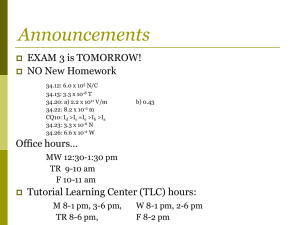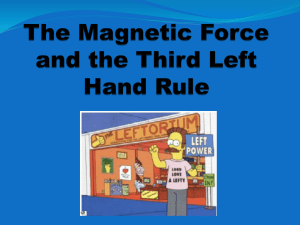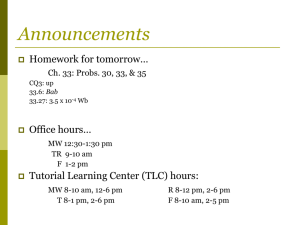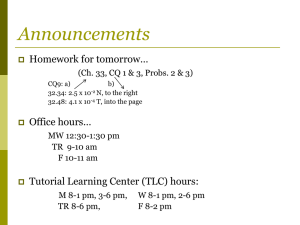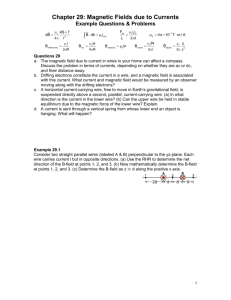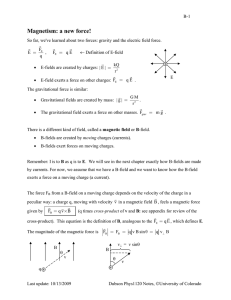Physics 1B Part II: Magnetism colors reversed
advertisement
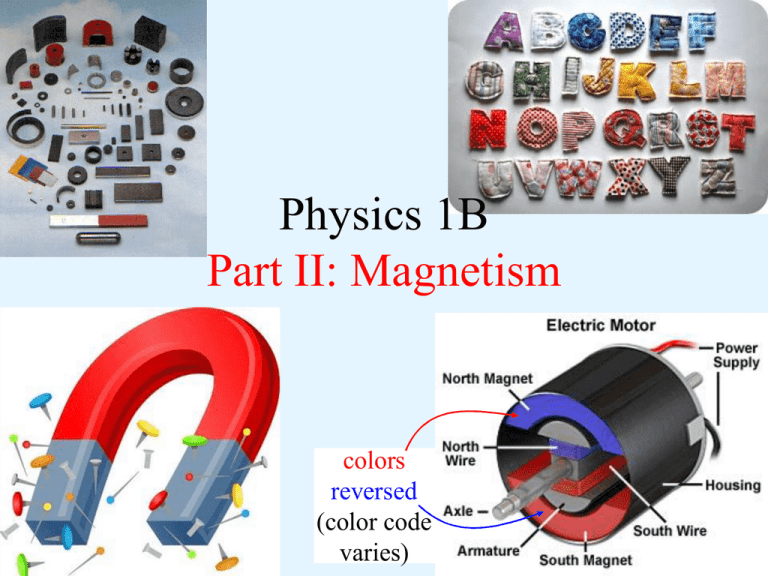
Physics 1B Part II: Magnetism 6/5/2012 colors reversed (color code varies) 1 We start with the macroscopic • What did historical people observe? • How do magnets behave? • Is electricity related to magnetism? • If so, how? • Then we proceed to the microscopic Michael Faraday Hans Christian Oersted • How do particles behave? • Lorentz magnetic force 6/5/2012 2 The nature of research “But Mr. Faraday, of what use is all this?” - unknown woman “Madam, of what use is a newborn baby?” - Michael Faraday “With electromagnetism, as with babies, it’s all a matter of potential.” - Bill Nye, the Science Guy 6/5/2012 3 Compass c. 4th century BCE • Two thousand years ago: • Hang lodestone from string: it point north • Magic! • But useful 6/5/2012 4 Magnets reinforce each other • Magnets align to create a stronger field • Magnets move to increase B-field • This is opposite of electric dipoles • Charges move to reduce E-field B-field points out of North end B-field points in to South end 6/5/2012 5 Where is the Earth’s magnet? B N C S A N S S N S E 6/5/2012 S N N D 6 The north face • Bulk materials are neither “north” or “south” • Only faces are • faces have magnetic lines of force piercing them • north faces attract south ends of compasses (B-field comes out) • south faces attract north ends of compasses (B-field goes in) The bulk volume cannot be called “north” or “south” S N south face Before I break it, the face looking left is already south; the face looking right is already north 6/5/2012 north face 7 Dipolar disorder • Break an electric dipole in two ... • You get one ++ and one -• Two monopoles • Only possible because lines terminate • Break a magnet in two ... • You get two dipole magnets • Magnetic lines never terminate • There are no magnetic “charges” N N N S N 6/5/2012 S S S 8 Electric charge doesn’t interact with magnets • But electric current does! • There is a connection between electricity and magnetism 6/5/2012 9 Electrical connection • A connection between electricity and magnetism • Compass points perpendicular to radius • Tangent to circle around wire I creates B-field creates N S I current out of page wire B 6/5/2012 B from slightly above B top view 10 A current carrying wire lies in the plane of the compass. How does the needle respond? A B C D E 6/5/2012 nothing N points left N points down N points right the compass explodes I 11 Force on a length of current • I and l must have consistent signs external B-field external B-field l l Fm = Il×B Fm = Il×B I 6/5/2012 from slightly above I top view 12 Units of B • Fm = Il×B => N = A-m[B] => [B] = N/(A-m) or tesla, T • Fundamentally, [B] = kg-m/s2/(C/s-m) = kg/(C-s) • But we don’t care about fundamental units here 6/5/2012 13 What is the net effect of the B-field on the current loop? A B C D E net force up net force down net torque clockwise net torque counter-clockwise nothing external B-field 6/5/2012 from slightly above I 14 What is the net effect of the B-field on the current loop? A B C D E net force up net force down net torque clockwise net torque counter-clockwise nothing external top wire B-field 6/5/2012 from slightly above I 15 Magnets from electricity: Biot-Savart • Current generates B-field • Voltage has no effect • Biot-Savart is the “Coulomb’s Law” of electromagnets dB(at P) km I ds rˆ r2 , dB k m I ds rˆ r2 km I ds sin r2 km 107 T-m/A I ds ds rˆ r P dB 6/5/2012 θ r̂ r P dB 16 What is the B-field from the given current element at P? A B C D E zero into the page out of the page up down I 6/5/2012 ds •P 17 Creating a magnetic dipole: a current loop • Current flows in loops: creates a magnetic field • Magnetic flux always forms closed loops • B-field inside the loop follows the right-hand rule • Outside, in the equatorial plane, B points opposite to inside axis N I B outside 6/5/2012 B inside S 18 Current loop in a B-field: redux • How are the given B-field and that produced by the loop related? • Magnetic forces pull & twist to increase the magnetic field top wire external B-field external B-field 6/5/2012 I B-field from loop net torque F F I 19 Our 2.5 right-hand rules (RHRs) RHR #1: B from current element B creates B I B from slightly above RHR #2: cross product y x z 6/5/2012 from #1 we can derive #3 RHR #3: B inside from a current loop axis N I B inside xy z S 20 Particles • Force of B-field on a conductor depends on current only, independent of the conductor • But different conductors have different mobile charge densities and average speeds: this tells us something • Consider 1-second’s worth of mobile charge in a conductor • It’s vd m long • Total mobile charge in the volume is Q = qn(vd A)(1 s) • Current through conductor of area A is: I Q Q qnvd A t 1s • Magnetic force on any current is: Fm I lB qnvd AlB one second’s worth of volume vd (1 s) A A 6/5/2012 external B-field I l 21 Particles (2) • Magnetic force on a wire is due to magnetic force on mobile charges (individual particles) in it: Fm I lB qnvd AlB Fm qvd nAl B qvd NB • Lorentz magnetic force on a single particle: Fm qvB Fm qv B • The macroscopic magnetic force tells us about the microscopic magnetic force • Total electromagnetic (EM) force • Force is a vector: vectors add: Ftotal qE qv B q E v B external B-field vd (1 s) A A 6/5/2012 I l 22 Newton’s 3rd law? • “And thirdly, the code is more what you’d call ‘guidelines’ than actual rules.” • Magnetic forces do not obey Newton’s 3rd guideline • But golly, professor, what of conservation of momentum? • Electromagnetic waves carry off the remaining momentum, and total momentum is © Walt Disney Pictures. Used without permission. So sue me. http://www.youtube.com/watch?v=bplEuBjppTw conserved • Between isolated particles, q1 B (@ q2) = 0 Coulomb forces dominate B2(@ q1) q2 1 => F21 = 0 • Magnetic forces are only F12 significant at relativistic speeds 6/5/2012 23 Ampere’s Law • Symmetry simplifies the B-field from a current • For any 2D surface: around B ds 0 Ithrough • Follows from Biot-Savart law • Similar to Gauss’ Law for any volume: B Bt φˆ r I 6/5/2012 qin Example: B from a wire ds Amperian loop Bds Bt 2 r 0 Ithrough 0 I Bt 2 r B Bt φˆ wire surface E dA Confusion over ds (should use dr in Ampere’s): In Biot-Savart, ds is length of current element. In Ampere’s Law, ds is displacement in space. 24 Solenoid: A better electromagnet • Multiple turns increase B-field • Permeable (e.g. iron) core increases B-field • Ampere’s Law in action soft magnetic N • Make 3 contributions zero • Solves for the core B-field ds B=0 ds very far Amperian loop B ds 0 Ithrough 6/5/2012 core Bh 0 N hI l ds very small, B•ds = 0 B 0 N I l I S 25 The magnetic facts of life: where do magnets come from? • They come from currents • But where do permanent magnets come from? • The stork brings them? • From microscopic currents in the magnet? • A teeny bit • From the intrinsic magnetic dipole moment of unpaired electrons 6/5/2012 26 Induced magnetic fields are not necessarily induced to reinforce • The induced field opposes the change in the primary field • Then, the resulting magnetic fields push and pull to reinforce as best they can • Or at least, to minimize cancellation induced current primary I 6/5/2012 B-field from induced current Snapshot when the primary current is first turned on (increasing) 27 Induced motional voltage (EMF) and current • We quantify the induced voltage from our existing knowledge • The conducting bar moves to the right with velocity, v • We will return to B-fields and work later moving conductor + charges accumulate ++ primary B-field l FB 6/5/2012 -− charges accumulate FB qv B, U e q vB V v ΔV q0 U e vB q The book calls this “electro-motive force”, or emf: E 28 Before equilibrium, which way is the current? A B C D 6/5/2012 up down all around zero FB qv B, U e q vB - l q0 v U e vB V q 29 If the mobile charges were positive, then before equilibrium, which way would the current be? A B C D 6/5/2012 up down all around zero FB qv B, FB U e qvB + l q0 v U e vB V q 30 Faraday’s Law, part 1 • Complete the circuit • Write the voltage in terms of flux B recall: area BdA E area EdA + We dA V vB B q dt R - A l v F primary B-field 6/5/2012 I − ΔV dB d BA dt dt Lenz’ Law: Induced current, I, creates secondary B-field which opposes the change in primary flux, ΦB 31 Faraday’s Law, the sequel • If multiple edges move, voltages add V segments Vi dB dt • An arbitrary shape is a sum of short segments: Faraday's Law: v + I R l primary B-field 6/5/2012 Vloop, RHR Lenz’ Law: current opposes change in flux, ΦB F − v v B t I R v A v 32 Faraday’s Law, part trois • It still holds for stationary wires and changing B-field: Faraday's Law: Vloop ,RHR B t • Cannot be derived from moving wires primary B increasing induced current top view R I A Lenz’ Law: current opposes change in flux, ΦB primary I increasing 6/5/2012 Snapshot when the primary current is first turned on (increasing) 33 Work and magnetic fields • There’s a subtlety: • Strictly speaking, magnetic fields do no work • Because the force is always perpendicular to the motion • But motors are magnetic, and they certainly do work • Strictly speaking, magnetic fields create electric fields, which do work • The net effect is that magnetic fields indirectly do work • I have ignored this indirection, and taken the results as work “done” by the magnetic field 6/5/2012 34
